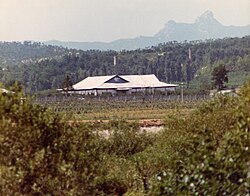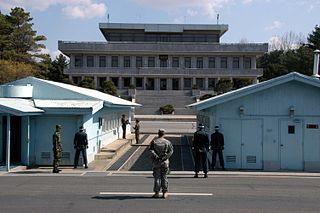
The Korean Demilitarized Zone is a heavily militarized strip of land running across the Korean Peninsula near the 38th parallel north. The demilitarized zone (DMZ) is a border barrier that divides the peninsula roughly in half. It was established to serve as a buffer zone between the countries of North Korea and South Korea under the provisions of the Korean Armistice Agreement in 1953, an agreement between North Korea, China, and the United Nations Command.

The Military Demarcation Line (MDL), sometimes referred to as the Armistice Line, is the land border or demarcation line between North Korea and South Korea. On either side of the line is the Korean Demilitarized Zone (DMZ). The MDL and DMZ were established by the Korean Armistice Agreement.

Located in the Joint Security Area (JSA), the so-called "Bridge of No Return" crosses the Military Demarcation Line (MDL) between North Korea and South Korea.
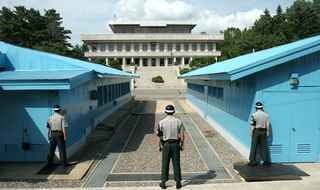
The Joint Security Area is the only portion of the Korean Demilitarized Zone (DMZ) where North and South Korean forces stand face-to-face. The JSA is used by the two Koreas for diplomatic engagements and, until March 1991, was also the site of military negotiations between North Korea and the United Nations Command (UNC).

United Nations Command is the multinational military force established to support the Republic of Korea during and after the Korean War. It was the first international unified command in history, and the first attempt at collective security pursuant to the Charter of the United Nations.
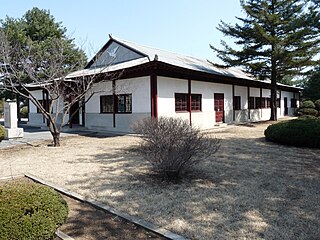
The North Korea Peace Museum is in the building constructed to house the signing of the Korean War Armistice Agreement on 27 July 1953. It is located in the former village of Panmunjeom (P'anmunjŏm) in North Hwanghae Province, North Korea.

Kijŏng-dong, Kijŏngdong, or Kijŏng tong is reportedly a Potemkin village in P'yŏnghwa-ri, Panmun-guyok, Kaesong Special City, North Korea. It is situated in the North's half of the Korean Demilitarized Zone (DMZ). Also known in North Korea as Peace Village, it has been widely referred to as 'Propaganda Village' by those outside North Korea, especially in South Korean and Western media.

Daeseong-dong is a village in South Korea close to the North Korean border. It lies within the Korean Demilitarized Zone (DMZ). The village is about 1.6 kilometres south of the Bridge of No Return, and 12 km from the city of Kaesong, North Korea. As of 2024, the village has 138 residents, mostly elderly.

Operation Big Switch was the repatriation of all remaining prisoners of the Korean War. Ceasefire talks had been going on between the North Korean, Chinese and United Nations Command (UNC) forces since 1951, with the main point of contention being the repatriation of all prisoners to their home countries, in accordance with Article 118 of the 1949 Geneva Convention. China and North Korea wanted prisoners to be compulsorily repatriated as outlined by the Geneva Convention but the UNC insisted that prisoners who wished to remain where they were be allowed to do so. After talks dragged on for two years, the Chinese and North Koreans relented on this point, and the Korean Armistice Agreement was signed on 27 July 1953.

Formerly a single nation that was annexed by Japan in 1910, the Korean Peninsula has been divided into North Korea and South Korea since the end of World War II on 2 September 1945. The two governments were founded in the two regions in 1948, leading to the consolidation of division. The two countries engaged in the Korean War from 1950 to 1953 which ended in an armistice agreement but without a peace treaty. North Korea is a one-party totalitarian state run by the Kim family. South Korea was formerly governed by a succession of military dictatorships, save for a brief one-year democratic period from 1960 to 1961, until thorough democratization in 1987, after which direct elections were held. Both nations claim the entire Korean Peninsula and outlying islands. Both nations joined the United Nations in 1991 and are recognized by most member states. Since the 1970s, both nations have held informal diplomatic dialogues in order to ease military tensions.
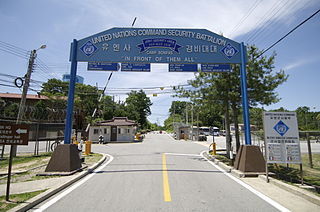
Camp Bonifas is a United Nations Command military post located 400 m (1,300 ft) south of the southern boundary of the Korean Demilitarized Zone (DMZ). It is 2,400 m (7,900 ft) south of the Military Demarcation Line, which forms the border between South Korea and North Korea. It was returned to the Republic of Korea in 2006.

The Third Tunnel of Aggression is one of four known tunnels under the border between North Korea and South Korea, extending south of Panmunjom.

The Neutral Nations Supervisory Commission (NNSC) was established by the Korean Armistice Agreement signed 27 July 1953, declaring an armistice in the Korean War. It is, with the Military Armistice Commission, part of the mechanism regulating the relations between the Democratic People's Republic of Korea and the Republic of Korea.

The Korean Armistice Agreement is an armistice that brought about a cessation of hostilities of the Korean War. It was signed by United States Army Lieutenant General William Harrison Jr. and General Mark W. Clark representing the United Nations Command (UNC), North Korea leader Kim Il Sung and General Nam Il representing the Korean People's Army (KPA), and Peng Dehuai representing the Chinese People's Volunteer Army (PVA). The armistice was signed on 27 July 1953, and was designed to "ensure a complete cessation of hostilities and of all acts of armed force in Korea until a final peaceful settlement is achieved."
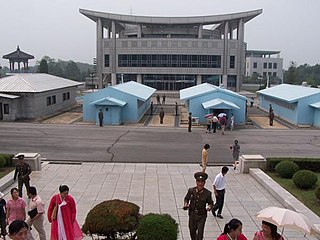
The Seoul–Pyongyang hotline, also known as the inter-Korean hotline, is a series of over 40 telephone lines that connect North and South Korea. Most of them run through the Panmunjom Joint Security Area (JSA) within the Korean Demilitarized Zone (DMZ) and are maintained by the Red Cross.
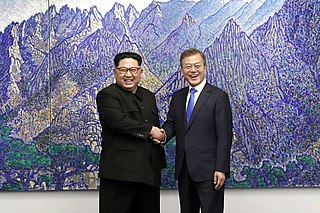
The April 2018 inter-Korean summit took place on 27 April 2018 on the South Korean side of the Joint Security Area, between Moon Jae-in, President of South Korea, and Kim Jong Un, Chairman of the Workers' Party of Korea and Supreme Leader of North Korea. The summit was the third inter-Korean summit - the first in eleven years. It was also the first time since the end of the Korean War in 1953 that a North Korean leader entered the South's territory; President Moon also briefly crossed into the North's territory.
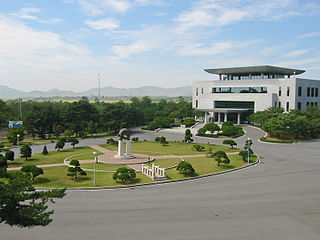
The Peace House is a venue for peace talks between North and South Korea. The building is situated in the Joint Security Area on the south side of the Military Demarcation Line bisecting the area. It is under the jurisdiction of the United Nations Command.

The Panmunjom Declaration for Peace, Prosperity and Reunification of the Korean Peninsula was adopted between the President of the Republic of Korea (ROK), Moon Jae-in and the President of the State Affairs Commission of the Democratic People's Republic of Korea (DPRK), Kim Jong Un, on 27 April 2018, during the 2018 inter-Korean Summit on the South Korean side of the Peace House in the Joint Security Area.

The May 2018 inter-Korean summit was the second inter-Korean summit in 2018. On 26 May, North Korean state chairman Kim Jong Un and South Korean president Moon Jae-in met again in the joint Security Area, this time on the North Korean side in the Inter-Korean Peace House in the Unification Pavilion. The meeting took two hours, and unlike other summits it had not been publicly announced beforehand. Photos released by South Korea's presidential office showed Moon arriving at the northern side of the Panmunjom truce village and shaking hands with Kim's sister, Kim Yo-jong, before sitting down with Kim for their summit. Moon was accompanied by Suh Hoon, Director of the National Intelligence Service of South Korea, while Kim was joined by Kim Yong-chol, a former military intelligence chief who is now a vice chairman of the North Korean ruling party's central committee tasked with inter-Korean relations. The meeting was largely centered around North Korean leader Kim Jong Un's upcoming summit with US President Donald Trump. Kim and Moon also embraced before Moon returned to South Korea. On 27 May, Moon stated in a public address that he and Kim agreed to meet again at "anytime and anyplace" without any formality and that the North Korean leader once again pledged to denuclearize the Korean Peninsula in accordance with the Panmunjom Declaration.
The September 2018 inter-Korean summit was the third and final inter-Korean summit in the 2018-19 Korean peace process.
